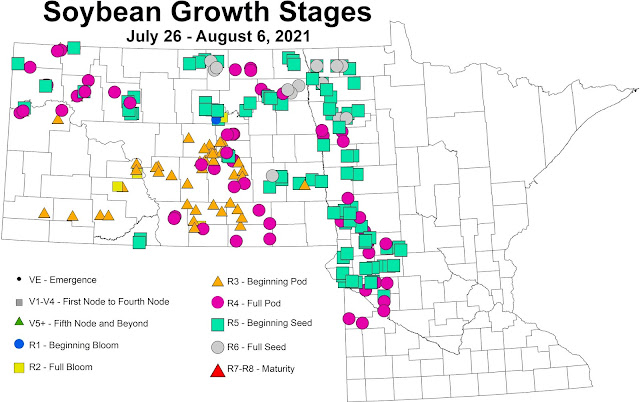Angie Peltier, Anthony Hanson and Jared Goplen, UMN Extension educators.
UMN Extension soybean IPM scouts traveled across northwest and west central Minnesota completing another couple of weeks of data collection. When visiting each soybean field, scouts first sweep for grasshoppers in the grassy area next to the field and then begin walking in a zig-zag pattern throughout the field, stopping along the way to growth stage the crop and examine 31 plants for soybean aphids, aphids that have been colonized by parasitic wasps and spider mites.
Growth stages.
For the most part, soybeans in northwest counties were at the beginning seed (R5) or full seed (R6) growth stages, maturing more quickly than soybeans further south (Figure 1). Further south, including in areas that have recently received rain, soybeans had all reached the full pod (R4) to beginning seed growth stages.
 |
Figure 1. Growth stages of soybeans scouted between July 26 and August 6 as part of the UMN Extension 2021 soybean IPM survey. Map source: NDSU IPM program.
|
Grasshoppers
Scouts used a sweep net to capture and count grasshoppers in the grassy area adjacent to each scouted soybean field. There were no field margins scouted in which adult grasshoppers were not found (Figure 2). The majority of fields had between 1 and 5 grasshoppers, fewer fields had 6 to 10 grasshoppers and two locations had more than 10 (15 and 12). While we didn’t see a lot of evidence of feeding injury, in travels last week throughout northwest Minnesota, we came across areas where grasshopper populations were so dense that they were bouncing off of the car’s windshield. UMN Extension has resources to help you to
determine whether crop injury and grasshopper densities indicate that treatment is warranted.
 |
Figure 2. Density of adult grasshopper populations along margins of fields scouted between July 26 and August 6 as part of the 2021 UMN Extension soybean IPM survey. Map source: NDSU IPM program.
|
Soybean aphids
If you’ll recall, one milestone that must be met to reach the soybean aphid
treatment threshold is for at least 80% of soybeans in a field to be infested. Only four fields in the southern half of the scouting area had the percentage of aphid infested plants approaching 80% (yellow triangles) and one field had 81% of plants infested (Figure 3). As soybean growth and development marches along, continued vigilance is needed as aphids still have the opportunity to reach treatment threshold population densities through pod fill.
 |
| Figure 3.The percentage of plants infested by aphids at field locations scouted between July 26 and August 6 as part of the 2021 UMN Extension soybean IPM survey. Map source: NDSU IPM program. | |
Another one of the conditions that must be met in order for the soybean aphid treatment threshold to be met is that there be an average of 250 aphids per plant up to pod fill (R6). An economic threshold has not been established for plants at or beyond pod fill. In the fields visited for this survey, an average of fewer than 21 aphids per plant were observed (Figure 4). Because under conditions favorable for aphid reproduction a new generation of pregnant females can be born
every 7 to 10 days and populations can double in as fast as 2 to 3 days, continued scouting is recommended.
 |
| Figure 4. The average number of soybean aphids per plant in fields scouted between July 26 and August 6 as part of the UMN Extension 2021 soybean IPM survey. Map source: NDSU IPM program. |
Spider mites
Due to the persistent drought throughout much of the state, two-spotted spider mite (TSSM) infestations have reach treatment thresholds in many fields. Scouts collecting field data for the IPM survey do not scout fields to determine whether treatment thresholds have been reached, rather they scout for presence/absence of TSSM both at the edge of fields, where infestations typically start, and inside of fields.
 |
| Figure
5. Presence or absence of spider mites on the edge of fields scouted between July 26 and August 6 as part of the UMN Extension 2021 soybean IPM survey. Map source: NDSU IPM program. |
 |
| Figure 6. Presence or absence of spider mites inside fields scouted between July 26 and August 6 as part of the UMN Extension 2021 soybean IPM survey. Map source: NDSU IPM program. |
Please note that while this scouting program can identify regions in which soybean aphid and two-spotted spider mite population densities are growing, it is no substitute for
diligently scouting your own fields. Fields scouted in this program were selected randomly without prior knowledge regarding seed- or post-applied insecticides, which can affect early-season aphid colonization.
Thanks to Minnesota Soybean Research & Promotion Council for funding this survey.





Comments
Post a Comment